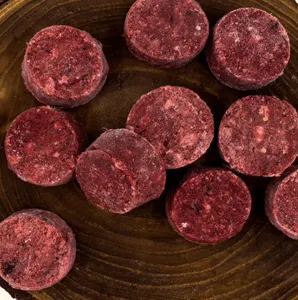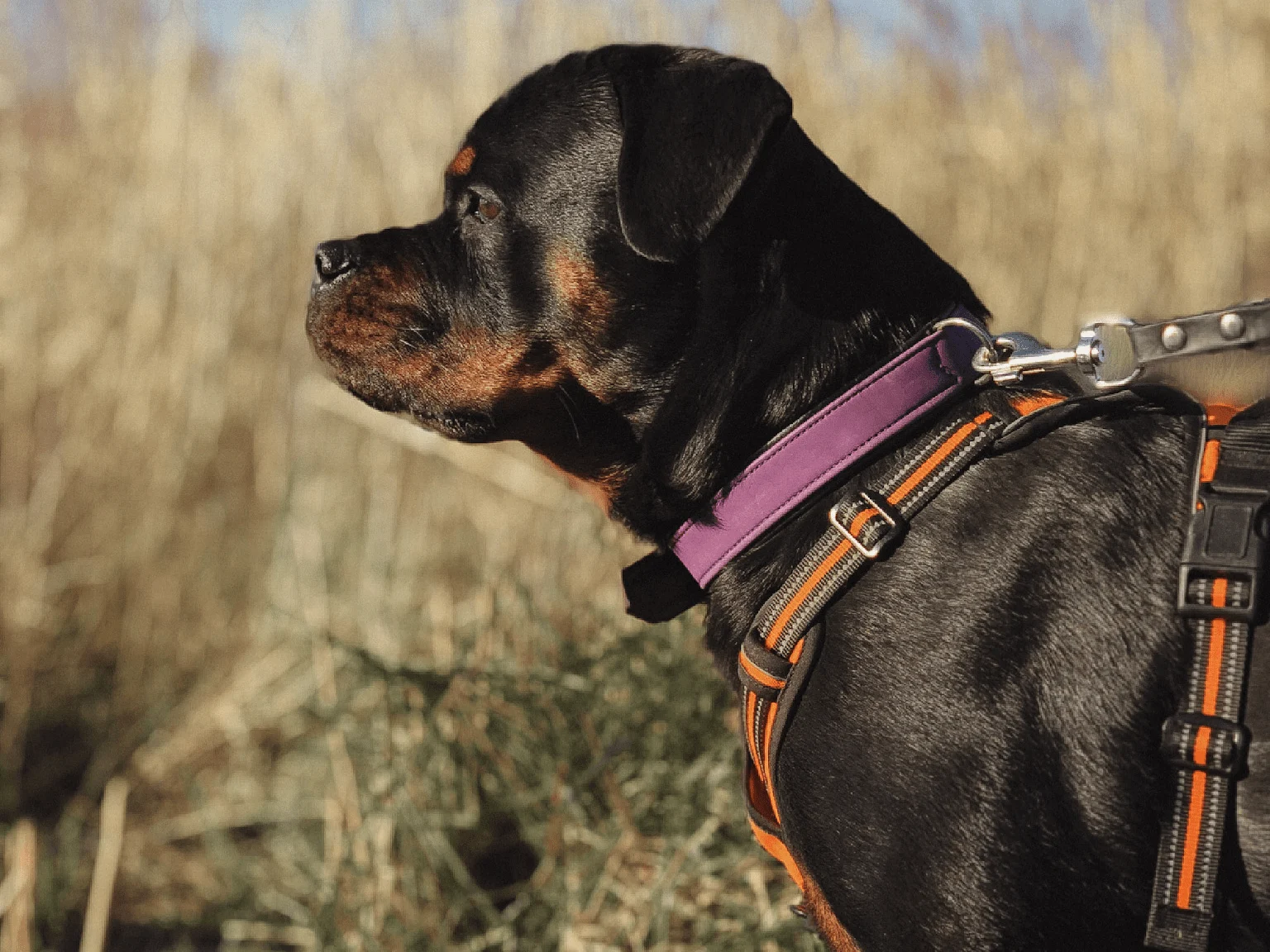A lot of myths are still out there concerning the raw dog food diet.
While it’s not a one-size-fits-all solution at all (no pun intended), I wanted to shed some light on the best practices of raw feeding and help you decide whether you should feed your adult dog or puppy with raw meat.
If you’ve been following our Instagram account, you probably already know that my Rottweiler Amalia is on a raw diet since she was a puppy (after a couple of months of hesitation).
Needless to say that she absolutely loves it (believe me, we know for sure – more on that below).
This article should act as a (kinda) comprehensive guide to help you decide if a raw diet is right for your dog and you.
We will also look into the different models and what model you should follow (Barf vs. Prey model).
Our Raw Diet Journey
To give you a rough idea of what we went through until we arrived at our Rottie’s current diet, here’s an overview.
Bear with me, I’ll tell you how to find raw meat for your dog below, along with tips that explain how you can feed your dog raw on a budget (super affordable options out there!).
B.A.R.F. Diet
We started out with feeding a BARF diet (meaning that we added fruit & vegetables and rumen on top of her muscle meat, meaty bones, and organ meat).
We used ground meat processed into little blobs.
Why? It’s easy to meal prep since every bag is made up of the same amount of ingredients with their respective percentages.
Our dog was never a good chewer anyway.
A lot of delivery services stock ground (or minced) meat.

If you’re a beginner, it’s great to use a complete menu in this form to introduce your dog to a new softer texture but I wouldn’t recommend this as a permanent diet.
Why should you miss the opportunity for your dog to use his jaw and feel the texture?
Keep in mind to adjust the diet to your dog.
For a dog that wolfs his meals down like crazy or for senior dogs, this might be a great option.
Not to mention the plus in terms of transparency you have with whole/sliced pieces of meat since it didn’t go through the grinder.
I only mention that because I’ve seen muscle meat mixed with organ meat and the label didn’t give any percentages.
She started on a day-to-day balanced diet, meaning that every day and even meal contained the exact percentage respectively from meat to fruit and vegetables, even if these numbers were odd.
Adding Meaty Bones
After a while, we started to add meaty bones (in order to stop supplementing calcium) but soon recognized that this was highly inconvenient since the bones were packaged in 2+ pound plastic bags.
Distributing wasn’t as easy as with ground meat anymore.
Since meal prep wasn’t so easy anymore, we started a semi-balanced diet, meaning that we occasionally had unbalanced meals with meaty bones only.
We always made sure she had a balanced week though.
What to avoid: Make sure not to give your dog cooked bones.
You might also want to skip the weight-bearing bones or at least take them away from your dog once he’s finished.
Necks are especially easy to chew through, followed by turkey legs/drumsticks.
Beef bones, feet, ribs, and tails can also be given but might be reserved for the more advanced chewer, depending on the animal they came from.
50/50 with High-Quality Kibble – Bad!
Now, we had the glorious idea to start feeding raw with high-quality kibble 50/50.
Plenty of advantages, right? Great to get your dog used to kibble in case you’re traveling.
Premium food has a lot of good ingredients stuffed into one tiny piece of kibble and it’s easy to prepare.
What should I watch out for when feeding or supplementing kibble (transition periods come to mind, definitely doable without adding kibble though)?
Your dog food should always contain a high amount of meat (>60%) with wild herbs, berries, etc. added to the mix.
Does kibble have to be grain-free? No, it doesn’t. In fact, a lot of “grain-free” kibble has peas as their main ingredient which isn’t good at all.
Nothing to argue against a high-quality kibble with rice on the third place or beyond on the ingredient list.
Anyway, as we neared the end of our current premium kibble bag, our dog started to dislike the taste and although she still ate, she wasn’t hyped at all anymore about her food (which if you knew her, was a red flag).
Her coat wasn’t as shiny anymore and she started shedding more. Well, back to her raw diet.
80/10/10 Prey Model
We switched to the prey model which means 80% muscle meat, 10% organ meat, and 10% raw meaty bones.
When I say prey model, I don’t mean “Whole Prey” but rather “Frankenstein Prey” (only bits and pieces from the former animal).
Taking into account that she was pretty much grown up by now, we also thought she might prefer the standard texture.
Switched to cut meat instead of ground meat.
Plot twist: This was even more inconvenient to meal prep, so we decided to go with balanced weeks only.
Some days have meat only, other days feature mornings with nothing but organ meat.
What We Feed Our Rottie Now
In the end, we decided to occasionally feed her fruit and vegetables (she loves Banana and about everything that’s edible) as well as rumen again.
Basically, we’re feeding a mixture of the barf and prey model.
Less fruit & vegetables and rumen than in a barf diet but more than in the prey model.
Sometimes we also switch from cut meat with balanced weeks to minced meat with balanced meals (several ingredients in one box).
Long story short: As long as your dog’s raw diet week is balanced, you’re fine.
Can I Feed My Dog Raw Ground Beef?
Short answer is yes, you definitely can.
This might the most common meat source for dogs on a raw diet but it’s important to note that (regardless if it’s raw or not), relatively many dogs react allergic.
There are options for dogs with allergies though and a raw diet makes it easy to sort the problem out if you know which animal is the culprit.
Where To Find Raw Meat for Dogs
Now you probably want to know where to find affordable raw muscle and organ meat.
- Local butcher
- Supermarket (especially chicken drumsticks, liver, etc.)
- Raw food stores (obviously)
- Delivery services (frozen minced and ground meat)
- Hunting (only if you’re allowed to, hardened and use the whole prey)
The local butcher often has great deals and is more than happy to help out, plus you always know where the meat is coming from.
In the process you’re supporting small business owners.
Options may vary depending on where you live but talking to your butcher and explaining your situation can actually help a lot with getting high-quality meat!
Another tip to save money on your dog’s raw diet: Buy in bulk and freeze it.
Seriously, we always buy nearly 100 pounds of meat and store it in a separate freezer.
Raw Diet on a Budget
If you’re on a budget, you should try to get bulk discounts.
Also, if you have a local butcher, try to establish a good relationship with their family business and they’ll be happy to hit you up if something’s extremely cheap or even free on short notice since many organs are just waste for the human food market.
If you want to know more about how much I actually pay for the raw diet of my 100 pound Rottweiler, check out this article about the lifetime cost of a large breed.

Pros and Cons of a Raw Dog Food Diet
Many people report similar advantages while opponents of the raw diet mostly point out the negative effects of not balancing your dog’s diet.
Check out what PetMd has to say and make sure to read up on the opinions of raw diet opponents to get a bigger picture.
Always do your research!
Pros:
- Less shedding, shinier coat
- Cleaner teeth (if you’re feeding bones)
- More energy (observed across all ages from pup to senior)
- Less stool that is more solid
Cons (a lot of which can be avoided with a proper raw diet)
- Nutrient deficiency if your dog’s raw diet isn’t balanced
- Danger of salmonella and other bacteria (always clean up feeding space)
- Dogs who love to gulp might choke on bones (supervision is key)
- Break teeth (no weight-bearing bones)
Let me know what your experiences with feeding raw are and if you have successfully transitioned your dog!
Disclaimer: This blog post does not substitute veterinary attention and does not intend to do so. I am not a veterinarian or pet nutritionist. If your dog shows any sign of illness, call your vet.
Sarah
Wednesday 17th of February 2021
I am getting a puppy this year (SO EXCITED!!) and I've been doing tons of research about training and diet to be prepared. I want to try a raw food diet for my dog but I'm still so confused, even after reading articles like these. Do you make your dog's entire meal from scratch, so to speak, or do you buy stuff premixed and prepackaged?
Danielle
Wednesday 17th of February 2021
Hi Sarah,
totally understandable. The world of raw feeding may seem confusing at first and good for you that you're looking into it!
So the thing is I just make sure my dog has a balanced week. If by "making every meal from scratch" you mean that I'm individually buying lean meat, organ meat, bones and then making sure every MEAL is balanced, no I don't do that. I buy the fresh meat, organ meat, etc. prepackaged from a local store in 2 lbs (1kg) packages (perfect size for me because I can give my dog half in the morning, half in the evening). Some days, it's 100% rumen and the next day it might be 70% organ meat, 30% lean horse meat. The day after that might be 80% rabbit meat and 20% fruits/vegetables.
That being said, the week always roughly amounts to 60% lean meat/15% organ meat/15% rumen/10% fruits/vegetables. The exact amounts are up to you and raw feeding is not an exact science. You just have to make sure that the weekly diet is balanced and avoid feeding weeks with 3-4x rumen only, for example. The source of the lean meat is also important because stuff like goat, rabbit, horse, turkey might be more expensive than chicken and beef (allergies for the latter two are quite common).
Other dog owners go out and buy everything individually and, as you mentioned, make the meal from scratch. That becomes quite a lot of work and really messy but you have 100% control over each day and can even make each day balanced instead of just having a balanced week.
The lazier fellows go out and buy it prepackaged with the correct weekly mix but spread over every day. These meals are ground together most of the time and what I don't really like about that is the lack of variety. Sure, every meal is balanced but the stuff is mixed so far, your dog probably doesn't want to eat it after a couple of weeks/months because it has the exact same texture and taste. Also, the sources of meat don't vary at all in these cases.
It always depends on what's available in your location. If you have the time and want to mix everything you bought from the organic store or local farmer, that's perfect. But maybe you have a local raw feeding shop and do it as I do it.
Hope that answers your question, Danielle